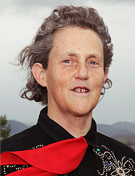Temple was asked to identify those factors that facilitated her successful transition and employment. Below is a short article from Temple on making the transition from high school to the workplace.
One factor that helped in my success is that I had learned how to work BEFORE I graduated from high school. Ideally work skill training needs to start in middle school with volunteer work that is on a schedule outside the home. I see too many kids who are over protected and they have never learned to do tasks for other people outside the home. Working under the direction of people outside the home should occur way before graduation from high school.
If you belong to a church, a job at the church is ideal. Every Sunday the child has to shake hands and pass out programs. Helping with the food for social events would also be good. Other possibilities are walking dogs for the neighbors, mowing lawns or assisting an elderly person. Parents need to find opportunities in their neighborhood.
In Colorado, teenagers can work in safe retail stores at 14 years old. Examples of safe retail would be tickets taken at a movie theater, grocery store or shoe store. Other states, the legal age is 16. The fully verbal child on the autism spectrum should transition into a real job as soon as they become the legal age. Parents and teachers need to work through their network of friends to find store managers who would be willing to work with their child.
Tips for Managers Working with Individuals on the Spectrum
- No long strings of verbal instruction. For tasks that are done in a sequence, provide a “pilots written check list.”
- Do not be vague. Social mistakes must be corrected like coaching somebody from a foreign country. Demonstrate correct behavior
- Instead of yelling “No” tell the person what they should do.
- A person on the spectrum may take longer to train, but they may do the task more accurately.
My work experience:
13 years – Hand sewed dresses for a freelance seamstress – Cash economy
15 years – Cleaned horse stalls
16 years – Did carpentry work and waited on tables at my aunt’s ranch
17 years – Painted signs and sold them
Too many kids are “jumping off” the service cliff when they age out. When the transition is started in high school, the cliff will be eliminated. For individuals who have aged out of the system, they will need to start a gradual transition and finally work up to a full-time job.
When I was a child, I had severe speech delay. I went to school with many kids with no speech delay who would be labeled on the autism spectrum today. In the 1950’s, they were labeled “geeks” and “nerds.” All of these people ended up getting and keeping jobs because my generation targets social skills in a more structured manner. Some of these individuals have owned businesses.
Grandin, T. (2016). Transition ideas. The Reporter, 21 (7). Retrieved from transition-ideas


